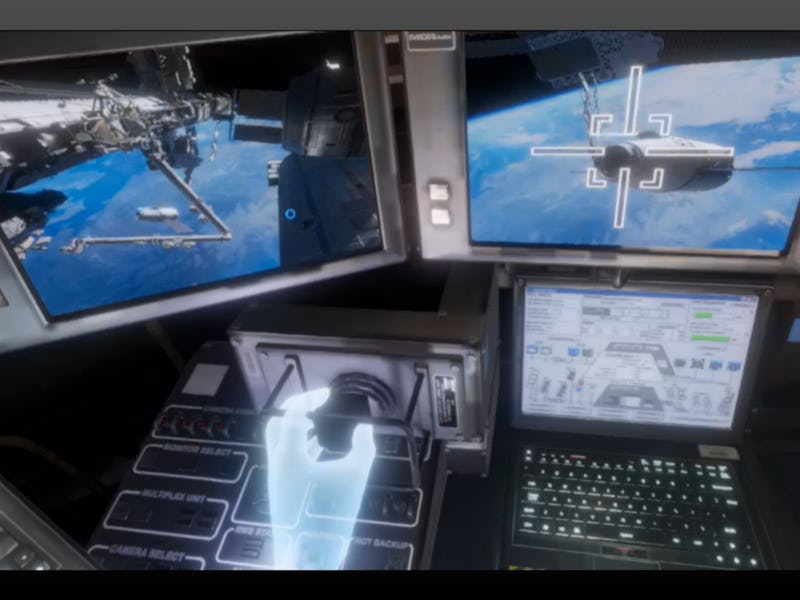Ben Grossman docked a SpaceX Dragon capsule to the International Space Station live on stage at MIT this weekend. Well, to be more precise, the visual effects supervisor who worked on such films as Hugo, Star Trek: Into Darkness, and Sin City tried to dock the capsule to the ISS. Actually, he kind of blew it. Fortunately, he was doing it in virtual reality, so the hundred million dollar capsule was only damaged in his Oculus headset.
On Sunday morning at MIT Media Lab’s event, “Beyond the Cradle: Envisioning a New Space Age,” Grossman demonstrated Mission: ISS, the virtual reality experience he helped develop. He shared the stage with author Warren Ellis — writer of Astonishing X-Men, as well as many other superhero and sci-fi books — and Douglas Trumbull, the visual effects pioneer responsible for 2001: A Space Odyssey and Blade Runner. The three science fiction visionaries shared their thoughts on how advances in sci-fi can shape the future of science.
The conversation rambled from VR to the nitty-gritty of filmmaking with motion capture technology — including Grossman’s recounting of actor Ben Kingsley’s difficulty acting against a green screen in Hugo — but a recurring theme emerged: Science fiction helps people realize what can be possible in the real world. In this way, the panelists agreed, art creates space for new realities.
Writer Warren Ellis and visual effects designer Douglas Trumbull look on as visual effects supervisor Ben Grossman approaches the International Space Station in virtual reality.
At one point during the panel, Ellis compared his writing to Trumbull and Grossman’s epic visual spectacles, saying that he was basically scratching on a cave wall by comparison. Trumbull disagreed, though. He said that writers like Ellis, by writing science fiction, determine what is possible.
“As a writer, you’re like the computer programmer for the human imagination,” said Trumbull. “You feed the minimum viable product into the human brain so that everybody can imagine something that is far more real than anything that we can create.”
Right after Trumbull praised Ellis for envisioning the impossible, the writer admitted he’d never experienced virtual reality. Grossman offered to let him try it on stage, but Ellis didn’t seem interested.
“It appears to be a completely enclosed experience, where you may well be immersed in something digital, but there is no sense of common culture there,” he said. “It may be a warped and stretched rectangle, but it is still a container.”
“What I’d like to know is if I’m right or wrong,” said Ellis.
“You’re wrong,” Grossman quickly replied with a smile.
Grossman then took center stage, sharing the Mission: ISS VR experience with the crowd. As he propelled himself down the corridors of the virtual space station, the audience could see his perspective projected on a big screen.
Contrary to Ellis’s prediction, Grossman’s VR experience seemed to unite the observers. As he manipulated the virtual joysticks to dock the ISS with the Dragon capsule, a voice in the audience reassured him.
“You’re doing a great job. Nobody’s scared yet,” said former NASA astronaut Cady Coleman. She sat in the audience alongside former NASA astronaut Leland Melvin, and they both beamed at the realistic images of the interior of the ISS.
Ben Grossman points to a VR Dragon capsule out of the ISS's Cupola module.
Coleman, who was the second person to dock a capsule with the ISS, went on to say that VR can actually help ground control get a feel for what astronauts experience when they’re performing tasks like that in orbit. Trumbull agreed, gushing about the experience.
“I was getting oriented on the ISS in a way I’ve never felt in my life,” he exclaimed. So perhaps just as VR and emerging immersive technologies can be used for entertainment, so too can they be used for furthering the aims of science.
